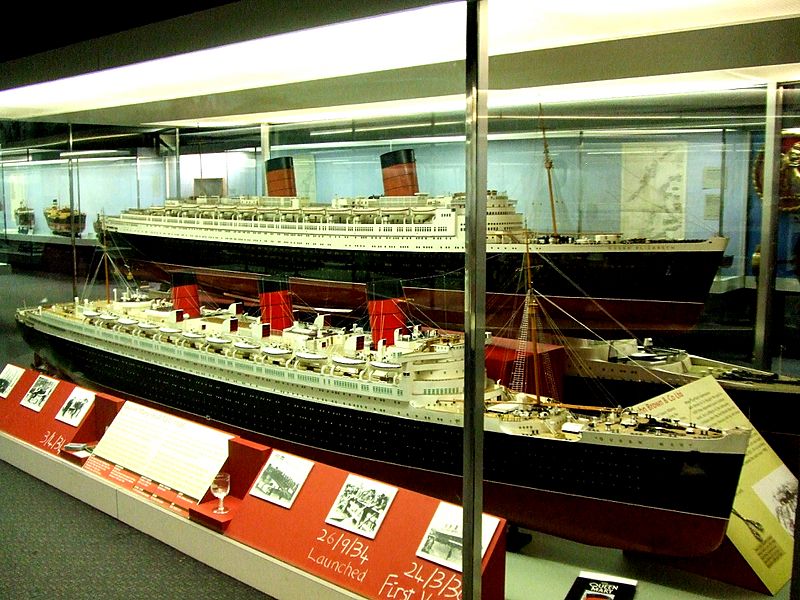Image: RMS Queen Mary (1936) (51022313917)

Description: A model of the Trans-Atlantic passenger liner RMS Queen Mary at the Glasgow Transport Museum, 2 March 2007. The Queen Mary was built by John Brown & Co., Clydebank, being launched in 1934 and completed in 1936 for the Cunard Line’s Southampton – New York ‘express’ service. She measured 1,018 ft x 118 ft x 39 ft, weighed 81,237 tons gross, had 200,000 shp steam turbines, 4 screws and a service speed of 28.5 kts. The Queen Mary was the largest ship in the world when completed but her great rival, the French Line’s SS Normandie completed the previous year, was enlarged from 79,280 tons to 83,243 tons to reclaim that title. Normandie was the holder of the Blue Riband of the Atlantic but the Queen Mary captured it in 1936 at an average speed of over 30 kts, despite her having a conservative hull design compared to the Normandie’s advanced hull. The Normandie (the engines of which were of similar power to the Queen Mary) was then fitted with a new set of propellers and retook the Blue Riband in 1937. The Queen Mary then made another attempt and achieved an average speed of 31 kts westbound and 31.7 kts eastbound, considerably over her designed service speed. The Queen held that record until 1952 when the new US United States took the Blue Riband. As well as the huge contrast in the conservative styling of the Queen Mary and the advanced, very stylish looks of the Normandie, there was another big contrast in their passenger accommodation. The majority of the Normandie’s accommodation was first class with the most lavish and luxurious furnishings, at the expense of the plainer Second and Third Classes. Also, the Art Deco style was of the slickest kind. In contrast, the Queen Mary had much more Second and Third Class accommodation which was finished to a high standard and its Art Deco style was far more restrained. However, although the critics favoured the undoubtedly very impressive Normandie, in service the Queen Mary proved far more popular amongst patrons. The 1930’s saw a boom in American tourists coming to Europe and they preferred the less-intimidating but still luxurious Second Class and Third Class accommodation of the Queen Mary and its less formal, more relaxed ambience. The Normandie had to rely on subsidies from the French Government as she was rarely over 60% capacity but the Queen Mary was very well patronised and did not need subsidies. In 1940 the Queen Mary was converted to a troopship and used to carry huge amounts of soldiers from Australia and New Zealand to England. After the USA entered the war, she carried even larger amounts of American troops to England. The Queen Mary resumed service with Cunard in 1947 but after jet aircraft were introduced on Trans-Atlantic flights in 1958, patronage dropped off but she (and the Queen Elizabeth, seen above and behind) was still carrying over 1,000 passenger per passage in the mid-1960’s. Nonetheless, the writing was on the wall. The new Cunarder RMS Queen Elizabeth 2 building would be more than sufficient for Cunard’s future needs and in 1967 the Queen Mary was retired, the last 3-funnelled liner in service. Fortunately, she is now preserved at Long Beach, USA.
Title: RMS Queen Mary (1936) (51022313917)
Credit: RMS Queen Mary (1936)
Author: Hugh Llewelyn from Keynsham, UK
Usage Terms: Creative Commons Attribution-Share Alike 2.0
License: CC BY-SA 2.0
License Link: https://creativecommons.org/licenses/by-sa/2.0
Attribution Required?: Yes
Image usage
The following 2 pages link to this image:

